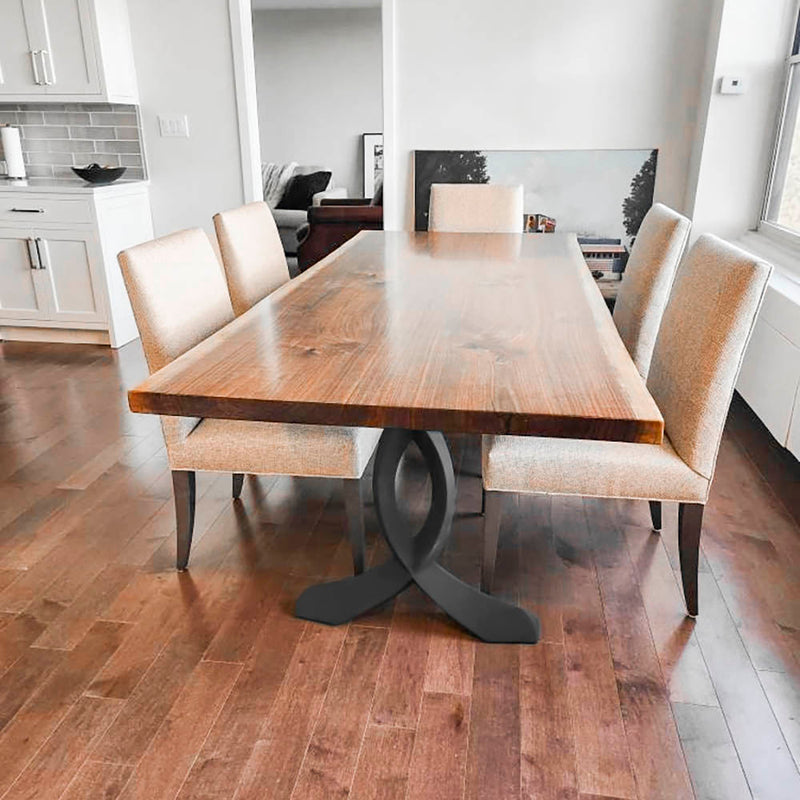Upgrade Your Furniture with Custom Dining Room Table Legs
Upgrade Your Furniture with Custom Dining Room Table Legs
Blog Article
From Conventional to Modern: Discover the Perfect Dining Room Table Legs for Your Style
While traditional styles such as cabriole and transformed legs evoke a sense of ageless elegance, contemporary designs like barrette and geometric options provide a chance for striking aesthetic interest. As you think about these aspects, the question stays: how can you flawlessly incorporate these diverse leg designs to create an unified eating experience?
Recognizing Table Leg Styles
The variety of eating space table leg styles can considerably influence both the appearances and functionality of the room. Each leg design contributes distinct functional features and visual components, accommodating varied layout preferences and usage requirements. Understanding these designs is crucial for picking the best eating table that aligns with your overall interior decoration vision.
For instance, tapered legs offer a clean, traditional look that can improve a room's sophistication, while stand bases supply security and make the most of legroom, making them ideal for smaller areas. Hairpin legs, a characteristic of mid-century modern design, introduce a commercial panache, permitting for a ventilated, open feeling. Trestle legs evoke rustic charm, providing robust support and a feeling of eternity.
Wood legs can bring heat and texture, whereas steel choices commonly share a smooth, contemporary vibe. Eventually, comprehending table leg styles is vital for creating a natural eating location that shows individual style while making certain usefulness and comfort.
Typical Table Leg Options
When selecting dining-room table legs, standard choices usually embody timeless elegance and workmanship. These layouts reflect a rich heritage and a commitment to high quality, making them ideal for those that value traditional looks.
Among one of the most iconic conventional leg styles is the cabriole leg, defined by its stylish bent shape. This design often features attractive makings and is most frequently discovered in Queen Anne and Chippendale furnishings. An additional preferred alternative is the transformed leg, which boasts a collection of smooth, rounded shapes that provide a classic look while maintaining stability.
Moreover, the straight leg, while basic, uses a durable and unadorned framework that can blend perfectly with a range of tabletop designs. For those drawn to ornate describing, claw-and-ball feet legs evoke a sense of splendour and can act as a magnificent focal factor in any kind of dining space.
Last but not least, stand bases, although not strictly legs, give a different standard alternative that permits ample legroom and can be magnificently carved. Each of these standard leg designs adds to the overall ambiance of a dining-room, marrying function with visual appeal.

Modern Table Leg Styles
Modern table leg designs offer a varied range have a peek at this website of styles that highlight clean lines and cutting-edge materials. These layouts typically focus on performance while offering as striking focal factors within a dining space. Minimal aesthetics prevail, with legs crafted from materials such as metal, glass, and engineered timber, which add to a modern and ventilated feel.
One prominent design is the barrette leg, identified by its slender, conical structure that gives stability without frustrating the table top (dining room table legs). This design is usually discovered in mid-century modern-day furnishings and can effortlessly complement various dining table shapes. Another pattern is the use of geometric forms, where legs might take on angular or asymmetrical forms, including aesthetic rate of interest and click this site a touch of creativity

Blending Styles for One-of-a-kind Rooms
Usually, homeowners seek to create one-of-a-kind eating areas that reflect their personal style by blending various style aspects. This strategy permits the incorporation of diverse visual appeals, causing an unified yet unique environment. For example, coupling a rustic wood table with smooth, contemporary steel legs can develop a distinctive comparison that raises the area's overall allure.
Additionally, incorporating vintage table legs with modern tabletops can evoke a feeling of history while preserving a modern perceptiveness. Such combinations not only showcase specific taste but also urge imagination, enabling property owners to curate a room that feels both personal and inviting.
Shade plays an important role in this mixing procedure; selecting table legs that match or contrast with the existing color pattern can enhance visual passion. Whitewashed legs can soften the daring of a dark table surface, creating a well balanced aesthetic.
Tips for Picking the Right Legs
Picking the right table legs is crucial for accomplishing both capability and visual charm in your eating room. Begin by thinking about the overall design of your area. Conventional setups profit from legs that feature detailed carvings or turned styles, while contemporary rooms may call for sleek, minimalist styles.
Following, analyze the height and security of the legs. dining room table legs. Standard table vary between 28 to 30 inches in height, visit the site so make certain the legs enhance this dimension for comfort. Furthermore, durable materials, such as hardwood or steel, can improve stability and longevity
Review the leg form also-- alternatives include right, tapered, or pedestal layouts. Straight legs offer a traditional look, while conical legs can include a touch of beauty. Pedestal bases give enough legroom and are optimal for smaller rooms.
Final Thought
In recap, selecting the optimal dining space table legs needs careful consideration of both conventional and modern-day styles. By harmonizing leg style, elevation, and material with the overall design, a natural and inviting environment can be attained.
The variety of dining room table leg styles can dramatically influence both the aesthetic appeals and performance of the room. Inevitably, recognizing table leg styles is necessary for developing a natural eating location that reflects individual style while ensuring practicality and comfort.One of the most iconic standard leg designs is the cabriole leg, identified by its stylish bent shape. Straight legs use a timeless appearance, while conical legs can include a touch of elegance.In summary, choosing the perfect dining room table legs calls for cautious consideration of both conventional and modern styles.
Report this page